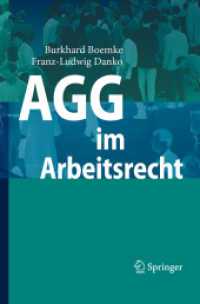- ホーム
- > 洋書
- > 英文書
- > Science / Mathematics
Full Description
Research into the anthropogenic and taphonomic processes that affect the formation of maritime archaeological resources has grown significantly over the last decade in both theory and the analysis of specific sites and associated material culture. The addition of interdisciplinary inquiry, investigative techniques, and analytical modeling, from fields such as engineering, oceanography, and marine biology have increased our ability to trace the unique pathways through which archaeological sites progress from initial deposition to the present, yet can also link individual sites into an integrated socio-environmental maritime landscape.
This edited volume presents a global perspective of current research in maritime archaeological landscape formation processes. In addition to "classically" considered submerged material culture and geography, or those that can be accessed by traditional underwater methodology, case studies include less-often considered sites and landscapes. Theselandscapes, for example, require archaeologists to use geophysical marine survey equipment to characterize extensive areas of the seafloor or go above the surface to access maritime archaeological resources that have received less scholarly attention.
Contents
Introduction.- Chapter 1 : A Dynamic Processual Maritime Archaeological Landscape Formation Model.- Chapter 2: Mapping the Coastal Frontier: Shipwrecks and the Cultural Landscape of the Early Republic Littoral.- Chapter 3: Collaboration, Collision and (Re)conciliation: Indigenous Participation in Australia's Maritime Industry—A Case Study from Point Pearce/Burgiyana, South Australia.- Chapter 4: The Formation of a West African Maritime Seascape: Atlantic Trade, Shipwrecks, and Formation Processes on the Coast of Ghana.- Chapter 5: Environment and Agency in the Formation of the Eastern Ship Graveyard in the Central Basin at Thonis-Heracleion, Egypt.- Chapter 6: Tsunami and Salvage: The Archaeological Landscape of the Beeswax Wreck, Oregon, USA.- Chapter 7: Coastal Erosion and Archaeological Site Formation Processes on Santa Rosa Island, California.- Chapter 8: Formation Processes of Maritime Archaeological Sites in Guadeloupe and the French West Indies: A First Approach.- Chapter 9:Conclusions/Discussion.








